

Our Tomorrow
by p. m. strain
Zona Gale Theatre
Portage Center for the Arts
Portage, WI
May, 2009
Scenic Design
by Jimmy Ray Ward
Costume Design
by Barbara Church
Lighting Design by Patrick M. Strain
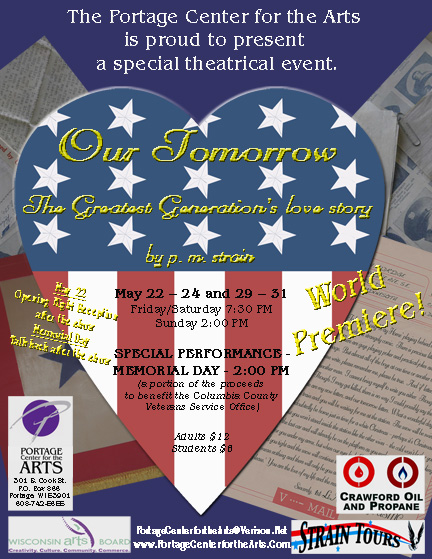
Poster design by Patrick M. Strain
For inquiries about performance royalties for this script, please e-mail me.
Selected research images:
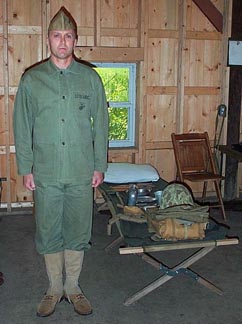 |
 |
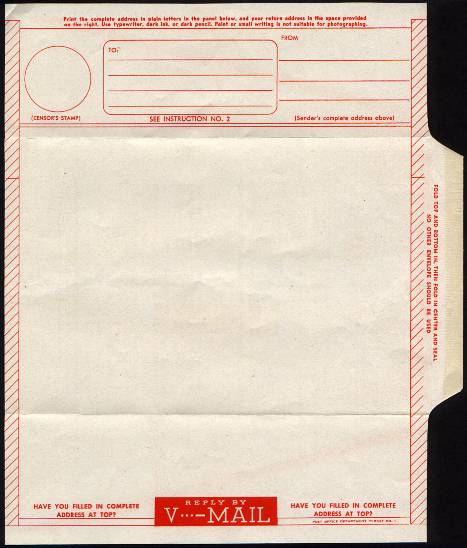 |
|---|---|---|
A soldier with cot and possessions. |
A foot locker. |
V-mail sheet. |
 |
||
A mock up of the map, coordinated with the scenic designer. |
|
|
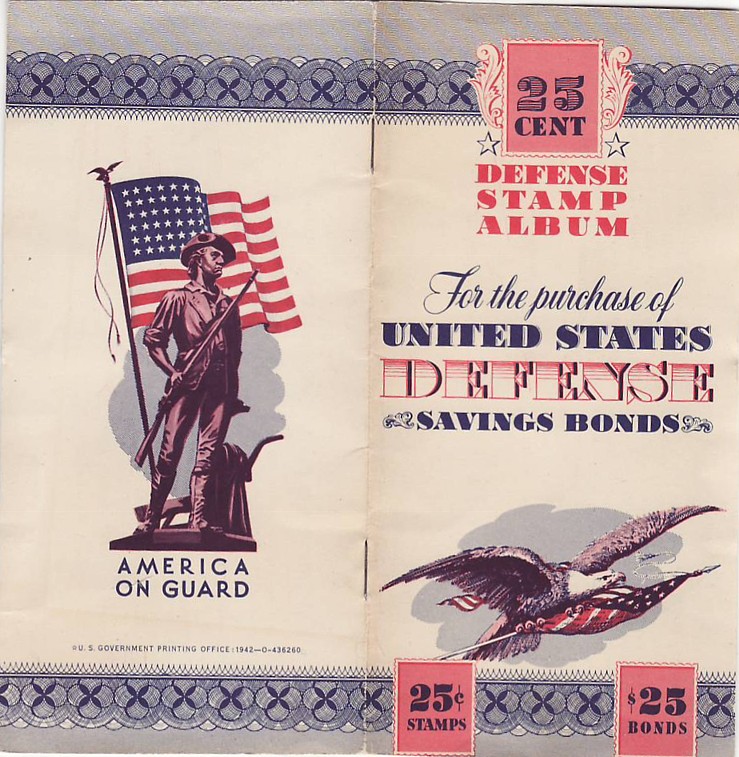 |
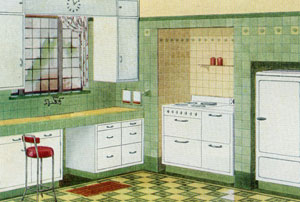 |
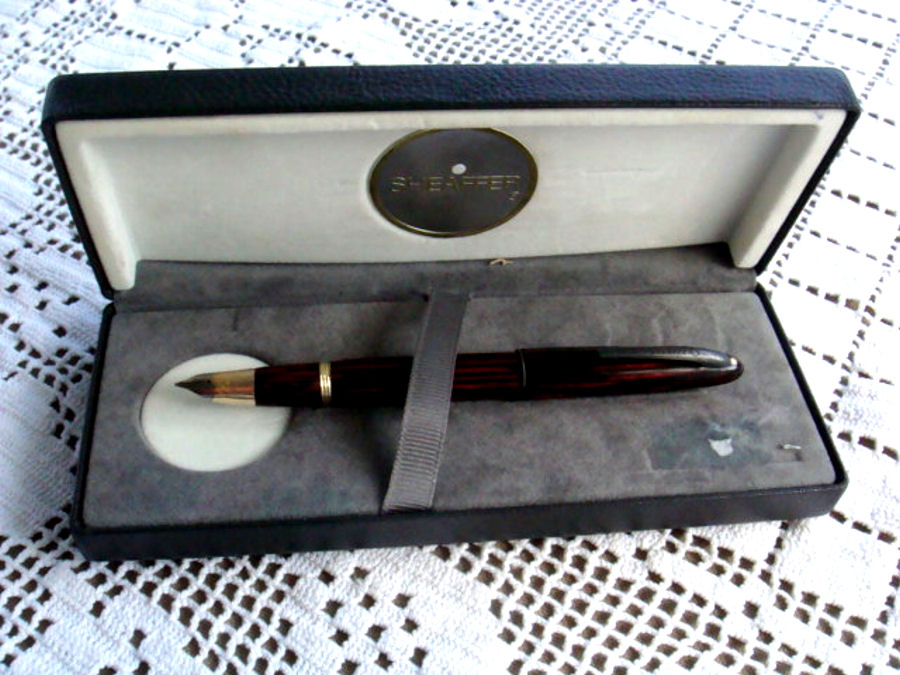 |
Saving bonds book. |
Kitchen, circa 1940's. |
Pen, circa 1940's. |
Production Photos:
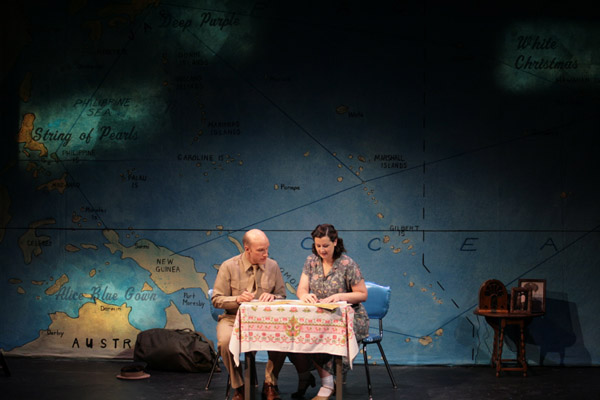
The opening of the show - naming islands with song titles.
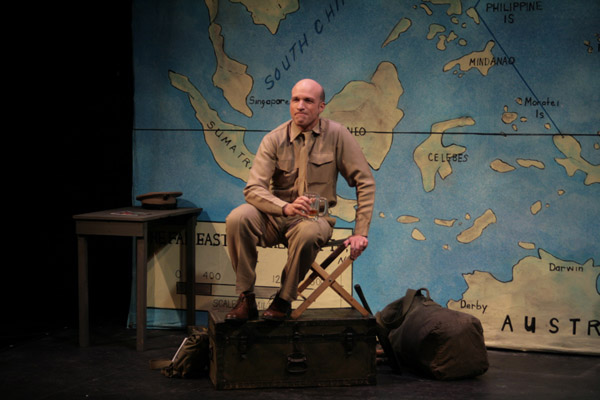
Arlen spends a short time in an Officer's Club.
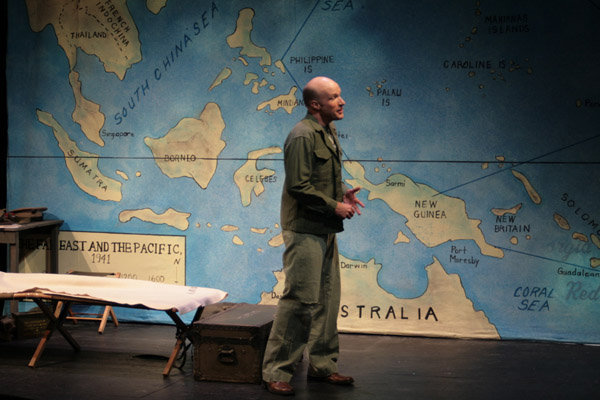
One of the secondary characters, the unsure Fritz.
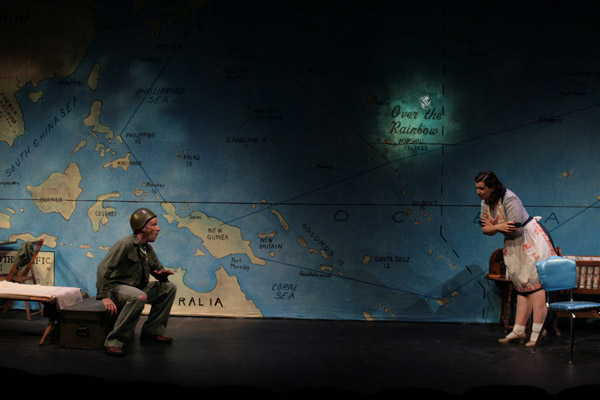
Another secondary character, the boisterous Morley, jokes with Muriel.
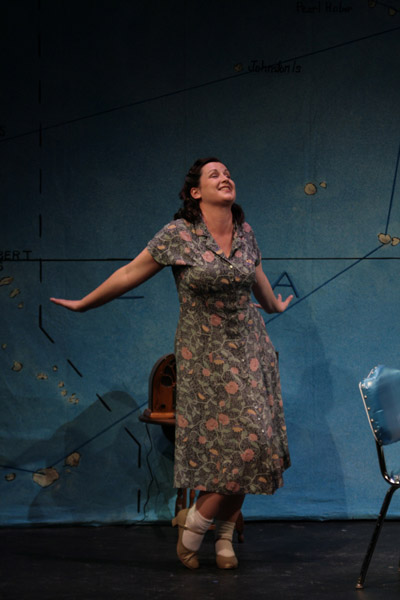
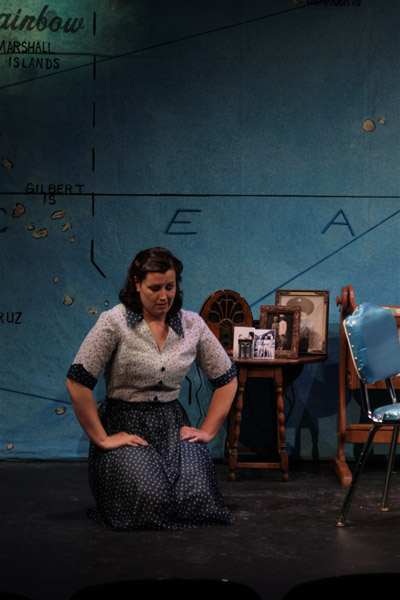
Secondary characters, the effervescent Angela (left) and the sarcastic Linda Jane (right). (Note: the costume change is a difference from Act 1 to Act 2, not a character costume change.)
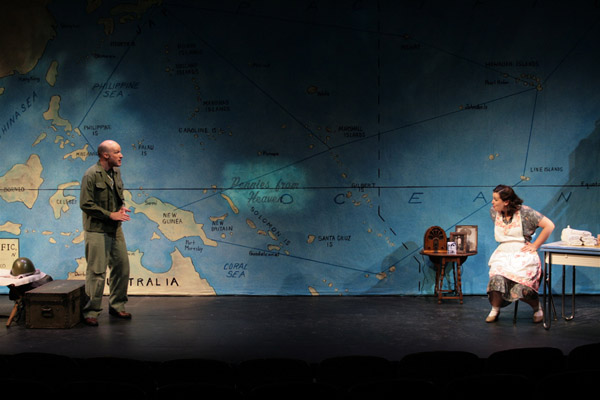
Fritz informs the pregnant Muriel about a baby pool he has started.
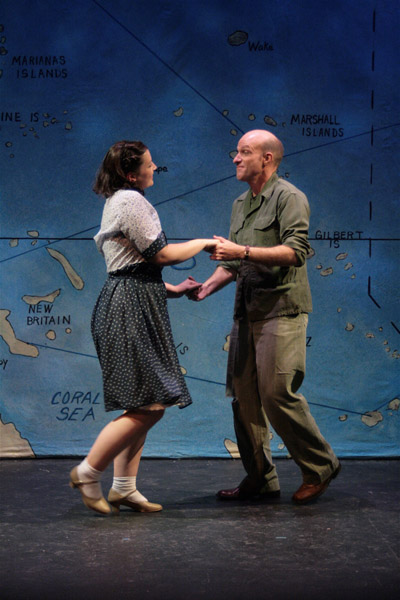
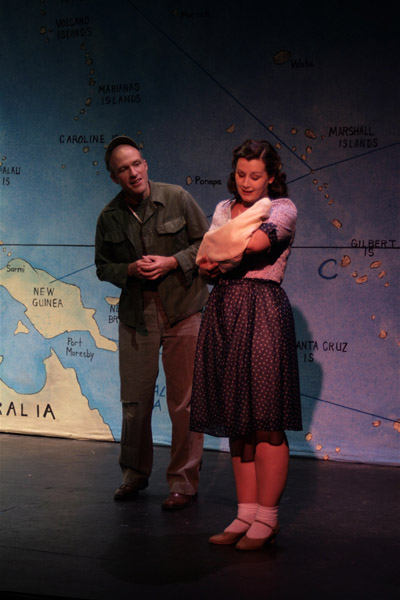
Arlen and Muriel in a dance fantasy (left) and at the top of Act 2, when the baby, Anne Marie, is born.
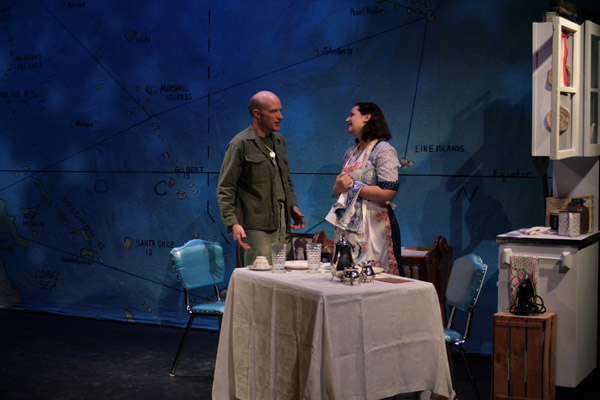
Her fantasy scene - the home life to come.
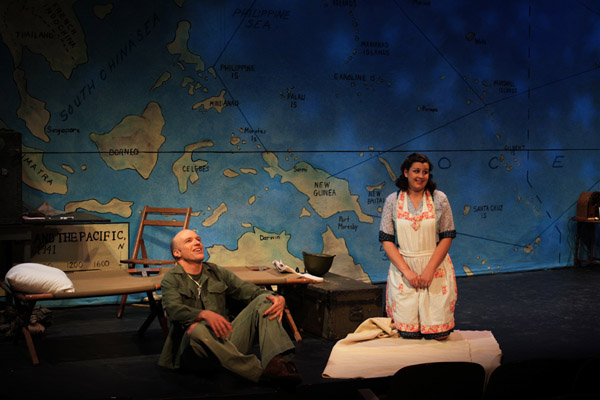
His fantasy scene - relaxing on the beach.
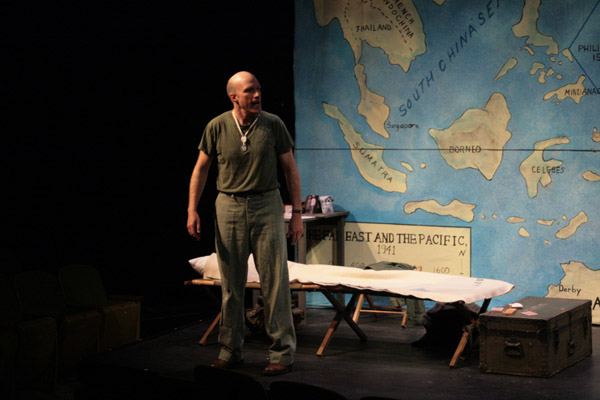
Arlen expresses some jealousy at his wife's social behavior at home.
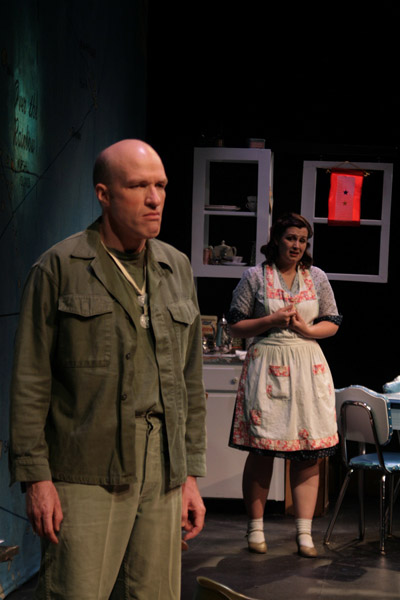
Arlen in the wake of a friend's death.
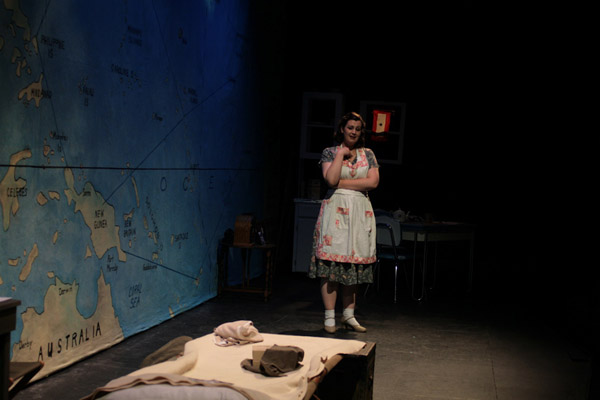
An anxious Muriel awaits news from Arlen.
Production Notes: So this is about the directing of the play. For more about the script and writing, please see my Playwrighting Page on this show. That is where I will also discuss the plot and analysis of the show, and you can read the opening scene.
Obviously, having written the show, having gone through readings and a staged reading with the Commonweal Theatre Company, I had an intimate knowledge of the script, but this being the first time in any kind of full production, there were still discoveries to be made. I had not given detailed thought to the specific action of the script, and had, much to my chagrin, underestimated the amount of props that would likely be needed to keep the show moving. The script contains no action specific dialogue - purposefully - and like many shows, when there is a long stretch of just dialogue, it falls to the actor and director to find the action that fits the words.
The major pitfall of the script, and a warning to future directors, is that it is, in essence, letters. Talky-talky. Yes, there are scenes of fantasy, etc that break up the communication, but most of the play is communicated through letters. However, two hours of watching people scribble just won't do. Even producers of Love Letters know you can't have the actors "writing" the whole time - they look at each other, interact with each other. So that was my primary goal, make these letters feel more like conversation and make the conversation feel as breezy and natural as possible, as if the two were really not separated by thousands of miles. Not that we never used the convention of holding a pad of paper and pen - Arlen especially has dialogue specific needs for a pad of paper, but for the most part we established the convention in a few moments of pen and paper, then turned to making the words a dialogue.
The staging, in broad terms, had always been in mind - his space, her space and a central location for dancing and other fantasy sequences, and with simple lighting adjustments, these flowed easily one from another. He moves around a lot and she changes location as well, but it seemed best to keep the scenery as limited as possible and let the audience use their imagination. After all, Muriel goes through the stages of pregnancy in Act 1, and we decided not to endeavor to create any "growing belly" - mostly for technical reasons, but also to keep the audience working - if she says she's pregnant and moves like a pregnant woman, do we need to do more? The plan for a backdrop of the islands, with the names of the songs that appear in silhouette was also a long-held concept, and one that worked well, both as visually gratifying and a theatrically evocative way to keep the audience, like Muriel, connected to Arlen's travels. The difficulty in the direction came moment by moment.
This was the first time in quite some time that I had worked with adult actors with extensive training in theatre. Most of my adult actors have been community theatre folks with good instincts, but little training. So, Amanda and Rob were a treat. I quickly learned to trust their instincts, and thus gave them a great freedom to experiment with actions. Amanda quickly fell into a domestic routine, complete with a tea ritual and regular cleaning. Had we more space, we probably would have endeavored for a bit of clothing ironing or the like, but our limited space kept us entirely in the kitchen. Rob found an amazing amount of things to do, especially since I didn't want him engaged in combat specific actions (explained in the playwrighting page). Though initial rehearsals had him polishing his boots a lot, he explored and we found things like shaving and calisthenics, along with the Act 2 load of a Captain's paperwork, really focused his character. The director in me cursed the playwright a bit for all the cards and photos that we referenced, but Rob found ingenious ways to hide and reveal these bits of paperwork and the action flowed easily out of their day to day routines.
As a theatre professional, I am nothing if not understated. I firmly believe that if the production - the actors, the design, etc - do too much work, the audience sits back and doesn't get engaged. The analogy I like to use is that if you show someone a complete triangle, they look at it and dismiss it. If you show someone three dots, their brain automatically connects the dots into a triangle and are thus, almost unwittingly, engaged. A good example in acting is crying. I tend to not like crying on stage. Why? First, it's often done so poorly, and then I am thinking about the actor's skills and not the story. The other is this idea of completing the triangle. If the character cries, you may find some in the audience who will cry with them - out of empathy - by more will think - "the character cried, so I don't have to." So I would rather watch a character fight back tears or express anger or sadness in another way. (This is not absolute by any means, but my predilection.) So...I shy away from extremes in acting and over specificity in design. One problem is that this show is about World War II, and it evokes extreme reactions - in the violence, in the loss, in the patriotism, in the sentimentality - and the actors, at times, wanted to push those emotions. I regularly encouraged them to make simpler choices, to let the audience do some work and they very soon anticipated when they had pushed too far. Not to say we didn't hit extremes. Act 2 especially is teeming with emotion, and when the arc of the play hit those moments, I certainly let the actors loose (and even then I encouraged simple expressions), but I think it is because we were conservative with our emotional displays early that we were allowed to be as expressive as we were late in the show.
The final challenge, which is much more the actors' (along with the volume of memorization of lines and prop movements) is the switches from Arlen to Fritz and Morley and Muriel to Angela, Linda Jane and Anne Marie. I found the actors quickly made strong physical and vocal choices that defined the characters and fell in close proximity to what was in my playwright's head. Linda Jane was the most difficult, and is, perhaps the least defined with vocal specificity, but the decision to cast her as an East Coast native, with it's accompanying accent, quickly made her sarcasm work with comedy and bite. From there, we simply found the moments in the script to make the sudden shift and go. There was no wishy-washing between characters, and if the audience was watching, they could see the actor move from one moment as one character and the next moment as the next. Many of these transitions were disguised while the opposite actor was speaking, but not always. This is, I admit, a great challenge to the actors, as it's not only a switch in voice and body, but in motivation as well - something I didn't feel in full until the actors really began to own the characters and get fully into their heads. It is a tribute to my actors that they were able to make this vocal, physical and emotional leaps with apparent ease.
For inquiries about performance royalties for this script, please e-mail me.